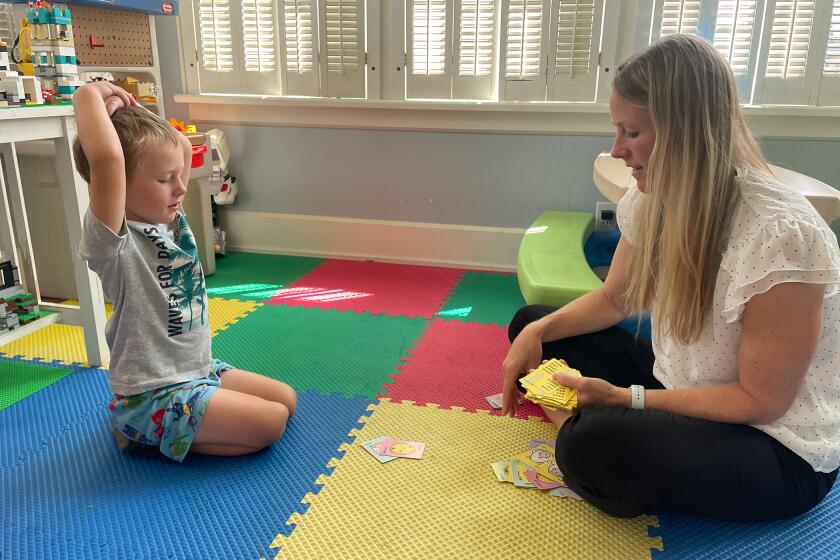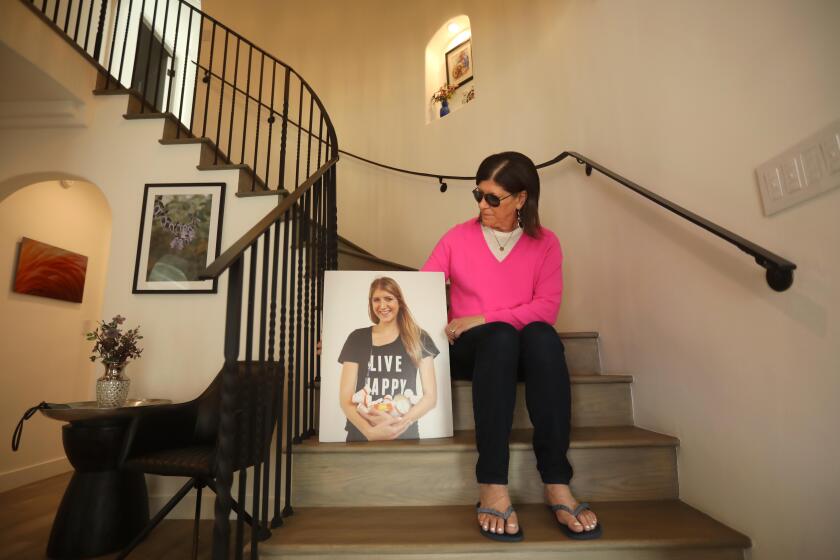Insulin-Therapy ‘Pioneer’ Says Feeling Better Is Her Reward
Barbara Ficker of Balboa laughingly recalls being a “middle-aged adolescent” during the 1970s.
She not only took up swimming and roller skating in those years, she did so with a passion, roller figure-skating and swimming competitively, and doing well enough in both sports to compete at the national level.
But in 1979, at 46, Ficker, who says she was always lean and active and had taken care of herself, suddenly began to feel “extraordinarily tired and somewhat nauseated.” Over a two-week period, she developed severe thirst and began to lose weight rapidly. “I knew,” she recalls, “something was terribly wrong.”
A blood test indicated that she had Type 1, or insulin-dependent, diabetes with an abnormally high blood sugar level.
Ficker, wife of architect and yachtsman Bill Ficker, who skippered the 1970 America’s Cup winner, was hospitalized and immediately started on insulin therapy, restricted diet and exercise modification. In a week she felt well enough to go home, but for reasons that remain uncertain, her blood-sugar level had not been stabilized.
With her energy frequently sapped by the inadequate metabolic control, Ficker was forced to give up skating and competitive swimming. She turned her attention to getting her diabetes under control.
In 1981, she volunteered for UC Irvine’s new Focused Research Program in Diabetes, an interdisciplinary program now conducting research on the eye, kidney and nerve diseases and psychosocial problems often associated with diabetes. The program’s clinical director is Dr. M. Arthur Charles, associate professor of medicine and physiology.
Through the program--in which virtually all the patients have difficult-to-manage cases of diabetes--Ficker tried multiple daily insulin injections. She tried a portable external pump that supplies a steady dose of insulin 24 hours a day. She became one of the first diabetics in the nation to test semisynthetic human insulin, and she participated in a variety of other insulin studies. In her case, nothing helped.
But now, via a referral from Charles, Ficker appears to have a solution to her problem.
She found it at the University of Utah, in Salt Lake City, where Dr. Robert L. Stephen, research associate professor at the University’s Institute of Biomedical Engineering, and his associates have had increasing success with what is medically known as a subcutaneous peritoneal access device.
The experimental device, implanted just beneath the skin of the abdomen, is a mushroom-shaped reservoir with a conduit that allows insulin to enter the abdominal cavity directly.
The patient, Stephen explained, inserts the needle through the skin and injects the insulin into the reservoir. A portion of the insulin goes directly to the liver, which is the natural route of natural insulin in non-diabetics; the remaining insulin stays in the reservoir, from where it is slowly and continuously released.
Better Than Injections
This method, Stephen said, has theoretical advantages over injecting insulin into other parts of the body.
“By injecting it into the arms or legs,” he said, “a lot of tissues receive more insulin than they would under ordinary conditions, and the liver receives less than it would under ordinary conditions: The liver, instead of being first in line to receive insulin, is just one of many organs in line.”
Stephen said the device, which is being developed through the efforts of the University of Utah School of Health Sciences and the School of Engineering, “is designed with the idea that, through improved blood-sugar control, there would be an improved outlook for the secondary complications of diabetes, including damage to the eyes, nerves and, primarily, the kidneys.”
Stephen said the device also, theoretically, would help patients such as Ficker who, in spite of multiple daily injections of insulin and full cooperation between patient and doctor, still have unstable blood-sugar levels.
A week before Thanksgiving, Ficker, with characteristic “total eagerness and extreme interest,” flew to Salt Lake City for the implant operation, which took about an hour. Four days later, she was back at her beachfront home on the Balboa Peninsula.
29th Test Patient
And Ficker, the 29th diabetic to undergo the procedure and the first from California, says the implant has made all the difference in the world.
“I feel so much better. It’s such a totally different feeling, it’s unbelievable,” said Ficker, who exudes warmth and friendliness. “I feel almost like I felt before I became a diabetic: almost normal, which is a big improvement over six years of feeling not up to par.”
Ficker, who has started roller-skating again--this time for pleasure only--said that before the implant “I never did feel totally well. If I would have a very busy day or stay out late at night, I would very definitely pay for it.”
Before the device was implanted, Ficker explained, her diabetes was never out of her mind. “It was always there; it was like a sore tooth or headache. I’d have to say, since the device has been working, there are periods during the day when I don’t even think about it. I’m much more relaxed, much more enthusiastic.”
Underscoring her enthusiasm are the results of a recent Hemoglobin A1c test, a long-term measurement of blood-sugar control, that showed her average blood-sugar level to be near normal.
Approaching Normal Range
“She’s doing much better,” said Charles, optimistically adding his prediction that “she’s going to get into the normal range. Her insulin absorption now is more predictable because of this insulin-delivery system.”
Unless she bumps the device or carries something against it, Ficker said, she doesn’t notice it’s there. “I’ve been running with it, swimming with it, and I went to yoga this morning--no problem.”
Ficker said she injects insulin into the device three times a day, before meals, and once at bedtime. (The dome of the device is made of an easily penetrable plastic, and normal tissue in-growth into the dome prevents back-leakage of injections, explained Stephen.)
“You feel it (the needle) going into the skin, but it’s more pressure than anything, because the skin is not that sensitive,” Ficker said.
Although Stephen says he and his colleagues at the University of Utah are encouraged by the results of their 4-year-long trial with the device, he emphasized that improvements still must be made.
Tissues Wall Off Device
The major problem they’ve encountered with the device, which is made of plastic materials, is that “the abdominal cavity resents long-term intrusion by foreign materials.” As a result, he said, “a new lining frequently grows across the device, and walls it off from the abdominal cavity. The mechanisms of exactly how this comes about are still under investigation.”
But, he said, “this obstructive lining can be removed by a relatively simple operation: The abdominal cavity is entered through the same operation scar, the lining is removed and the scar is resutured, so the patient has a functioning device and no additional scar.”
Although Stephen said the types of materials used to make the device have been markedly improved, they still are searching for materials that will be more acceptable to the body. Until then, he said, the operation “has proven to be a satisfactory interim measure.”
Yet another drawback to the implant is that the abdominal skin just over the reservoir, with repeated needle punctures, becomes tough and somewhat scarred after three to four years, said Stephen. In that case, he said, “a new device is implanted through the same scar but in a different position, so that fresh skin overlays the new device and a section of the old scarred skin is removed. The end result is a new device, fresh skin overlying it, and the patient still has just the one operation scar.”
Tested for 3 Years
Stephen said that improved materials combined with the surgical restorative technique to remove the obstructive lining have resulted in 80% of the devices functioning for longer than 12 months. He added that six of the 29 patients who have had the implant have been using the device more than three years, and one patient has been using it more than four years, although “they required the cleaning-up operation or a change of device to keep going that long.”
Stressing that the device is still in its experimental stages, Stephen said, “the preliminary results in kidney disease due to diabetes are promising enough to warrant long-term control studies. The results have shown in some individuals a slowing in the deterioration rate of the kidneys, and in two cases the kidney disease was actually arrested.”
“There are some individual cases that are very gratifying,” he added. “Barbara (Ficker) has done very well indeed. She was having terrible troubles just maintaining a normal life style and now she doesn’t.”
Not ‘Ultimate Solution’
Stephen, however, does not go so far as to say the device is the ultimate solution to Ficker’s inability to stabilize her blood sugar levels.
“It’s at least a temporary solution,” he said, noting that it’s possible that “she may lose good metabolic control for reasons we don’t understand. You can say we’ve bought time and a feeling of general well-being that just didn’t exist before. She may do perfectly well on this thing for years.
“As it stands now everybody is pleased: the referring doctor, myself and the patient.”
Despite Ficker’s improved condition, her days as a research volunteer are not over.
“I’ll participate in anything I can, especially eyes and kidneys (research),” said Ficker, who is president of Medical Research Associates of UCI, the university’s medical research support group.
“I’m extremely curious about medicine, so this is a wonderful way to be involved. It’s fun to be a pioneer, it really is.”



